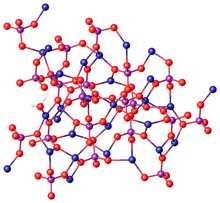Copper(II) phosphate

| |

| |
| Names | |
|---|---|
| IUPAC name
copper(II) phosphate
| |
| Other names
tricopper diphosphate
tricopper bis(orthophosphate) | |
| Identifiers | |
3D model (JSmol)
|
|
| ChemSpider | |
| ECHA InfoCard | 100.029.322 |
PubChem CID
|
|
| UNII | |
CompTox Dashboard (EPA)
|
|
| |
| |
| Properties | |
| Cu3(PO4)2 | |
| Molar mass | 380.580722 g/mol (anhydrous) 434.63 g/mol (trihydrate) |
| Appearance | light bluish-green powder (anhydrous) blue or olive crystals (trihydrate) |
| insoluble | |
Solubility product (Ksp)
|
1.4×10−37[1] |
| Solubility | anhydrous: soluble in ammonia trihydrate: soluble in ammonium hydroxide slightly soluble in acetone insoluble in ethanol |
| Structure | |
| orthorhombic (trihydrate) | |
| Hazards | |
| NIOSH (US health exposure limits): | |
PEL (Permissible)
|
TWA 1 mg/m3 (as Cu)[2] |
REL (Recommended)
|
TWA 1 mg/m3 (as Cu)[2] |
IDLH (Immediate danger)
|
TWA 100 mg/m3 (as Cu)[2] |
| Related compounds | |
Other cations
|
Iron(II) phosphate |
Except where otherwise noted, data are given for materials in their standard state (at 25 °C [77 °F], 100 kPa). | |
| Infobox references | |
Copper(II) phosphate are inorganic compounds with the formula Cu3(PO4)2.n(H2O). They can be regarded as the cupric salt of phosphoric acid. Anhydrous copper(II) phosphate is a blue solid. It is produced by a high-temperature reaction between diammonium phosphate and copper(II) oxide.[3]
- 2 (NH4)2HPO4 + 3 CuO → Cu3(PO4)2 + 3 H2O + 4 NH3
Structure[]
In terms of structure, copper(II) phosphates are coordination polymers, as is typical for most metal phosphates. The phosphate center is tetrahedral. In the anhydrous material, the copper centers are pentacoordinate. In the monohydrate, the copper adopt 6-, 5-, and 4-coordinate geometries.[4]

Minerals[]
It is relatively commonly encountered as the hydrated species Cu2(PO4)OH, which is green and occurs naturally as the mineral libethenite. Pseudomalachite, Cu5(PO4)2(OH)4, is the most common Cu phosphate in the nature, typical for some oxidation zones of Cu ore deposits.[5][6]
References[]
- ^ John Rumble (June 18, 2018). CRC Handbook of Chemistry and Physics (99 ed.). CRC Press. pp. 5–188. ISBN 978-1138561632.
- ^ a b c NIOSH Pocket Guide to Chemical Hazards. "#0150". National Institute for Occupational Safety and Health (NIOSH).
- ^ Shoemaker, G. L.; Anderson, J. B.; Kostiner, E. (15 September 1977). "Copper(II) phosphate". Acta Crystallographica Section B. 33 (9): 2969–2972. doi:10.1107/S0567740877010012.
- ^ Effenberger, H. (1985). "Cu3(PO4)2 · H2O: Synthese und Kristallstruktur". Journal of Solid State Chemistry. 57 (2): 240–247. Bibcode:1985JSSCh..57..240E. doi:10.1016/S0022-4596(85)80014-1.
- ^ [https://www.mindat.org/min-3299.html Pseudomalachite on Mindat
- ^ https://www.ima-mineralogy.org/Minlist.htm
External links[]
- Handbook of chemistry and physics http://www.hbcpnetbase.com/
- Copper(II) compounds
- Phosphates
- Inorganic compound stubs